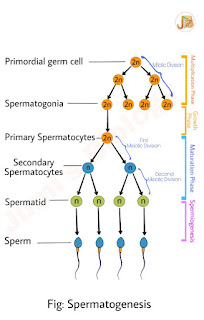Common Infectious Diseases in Humans ||Class 12 Biology
Infections diseases are classified on the basis of pathogen. Some common diseases in human are as follows:
1. Bacterial diseases:
i) Typhoid: It is caused by bacterium (Salmonella typhi) which enters the small intestine through food and water and migrate to other organs through blood.
Symptoms: High fever (39-40°C), weakness, stomach pain, constipation, headache, loss of appetite.
Widal test is done as a confirmation test for the typhoid
ii) Pneumonia: It is caused by the bacterium Streptococcus pneumoniae and Haemophilus influenzae which infect alveoli of the lungs. The alveoli get filled with fluid causing decrease in respiratory efficiency of the lungs.
Pneumonia spreads by inhaling droplets or aerosol from infected individuals or even by sharing glasses and utensils with patients.
Symptoms: Fever, chills, cough, headache etc.
2. Viral Disease:
i) Common cold: It occurs due to a group of viruses called rhinoviruses which infect the nose and respiratory passage but not the lungs. The infection occurs due to droplets from cough or sneezes of an infected person.
Symptoms: Nasal congestion and discharge, sore throat, hoarseness, cough, headache, tiredness etc which generally last for about 3-7 days.
3. Protozoan disease:
i) Amoebiasis (amoebic dysentery): It is caused by an intestinal endoparasite, Entamoeba histolytica which is found in large intestine of humans. The carrier of pathogen is housefly which transmits the parasite from faeces of infected person to the food, thereby contaminated them. Infection during this disease takes place through the contaminated food and water.
Symptoms: Abdominal pain, cramps, faeces with excess mucous and blood clots etc.
4. Fungal Disease:
i) Ringworm: It is the common fungal disease caused by many fungi of genera: Microsporum, Trichophyton and Epidermophyton. Heat and moisture help these fungi to grow in regions like skin, folds as in groin or between toes. Infection occurs through contact with an infected person or from soil and through the use of towels, clothes, combs etc of an infected person.
Symptoms: Ringworm are appearance of dry, scaly lesions on various parts of the body such as skin, nails and scalp accompanied by intense itching.
5. Helminthic Diseases:
i) Ascariasis: It is caused by an intestinal endoparasite of human. Ascaris lumbricoides commonly known as roundworm. Infection occurs as the eggs of parasite are excreted along with the faeces of infected person which contaminate water, soil, plants etc and reaches to the human beings through contaminated vegetables, fruits, water etc.
Symptoms: Abdominal pain, indigestion, muscular pain, fever, anaemia, nausea, headache and blockage of intestinal passage.
ii) Filariasis or Elephantiasis: It is caused by filarial worms, Wuchereria bancrofti and Wuchereria malayi. Female Culex mosquito is the vector of this disease.
Symptoms: Inflammation of organs in which they live for many years, normally affects limph vessels or lower limbs resulting in swelling, hence called elephantiasis. In this disease, genital organs also get effected leading to their deformation.



Comments
Post a Comment
If you have any doubts,please let me know